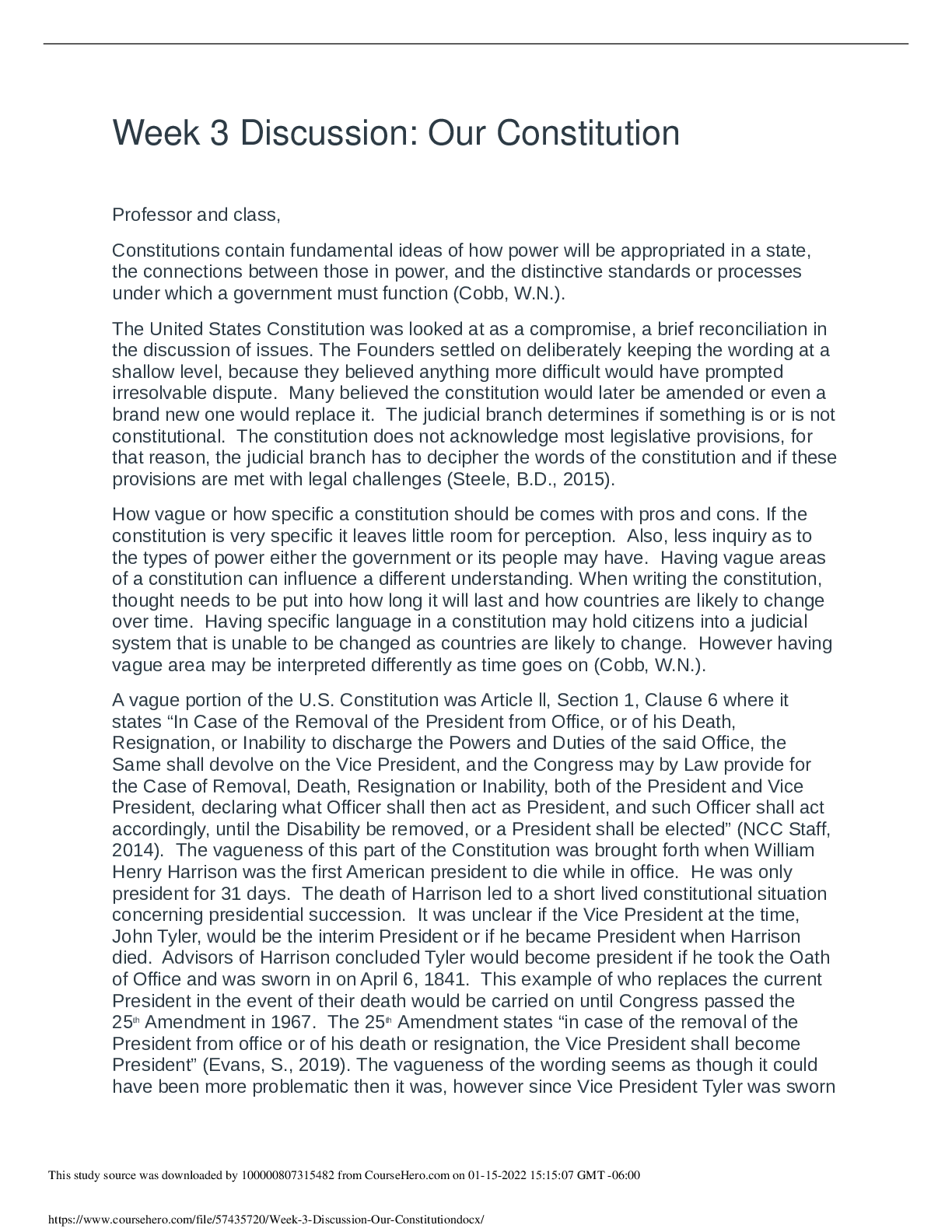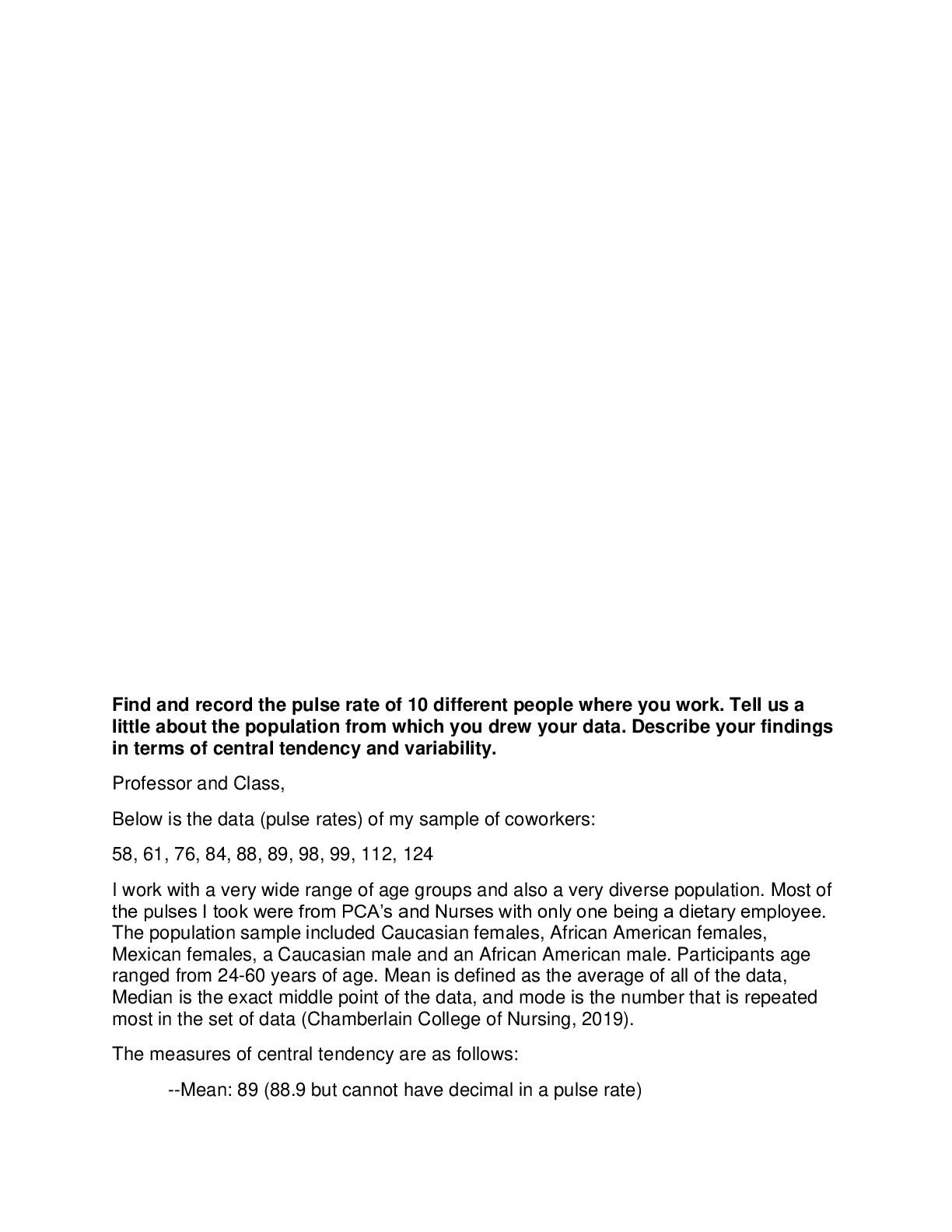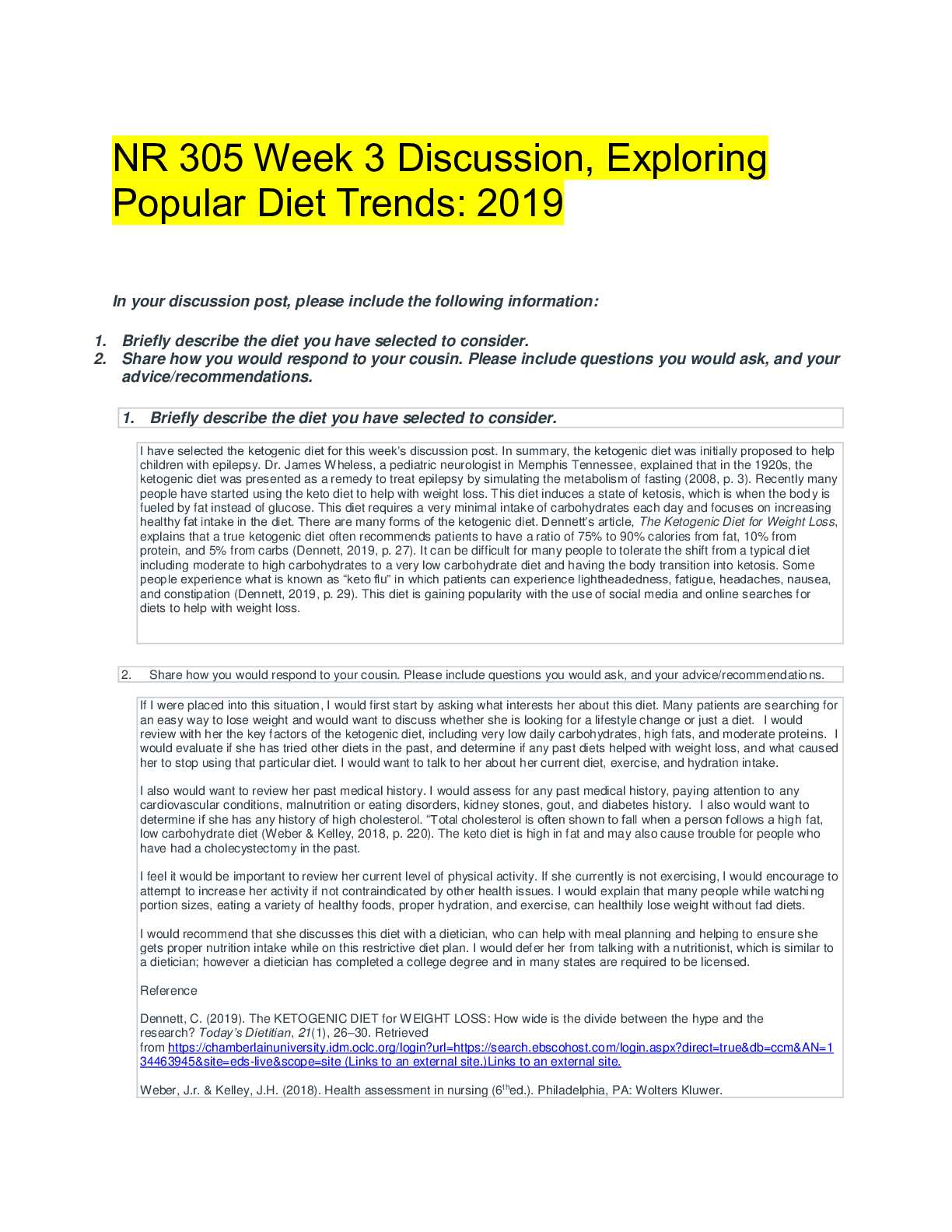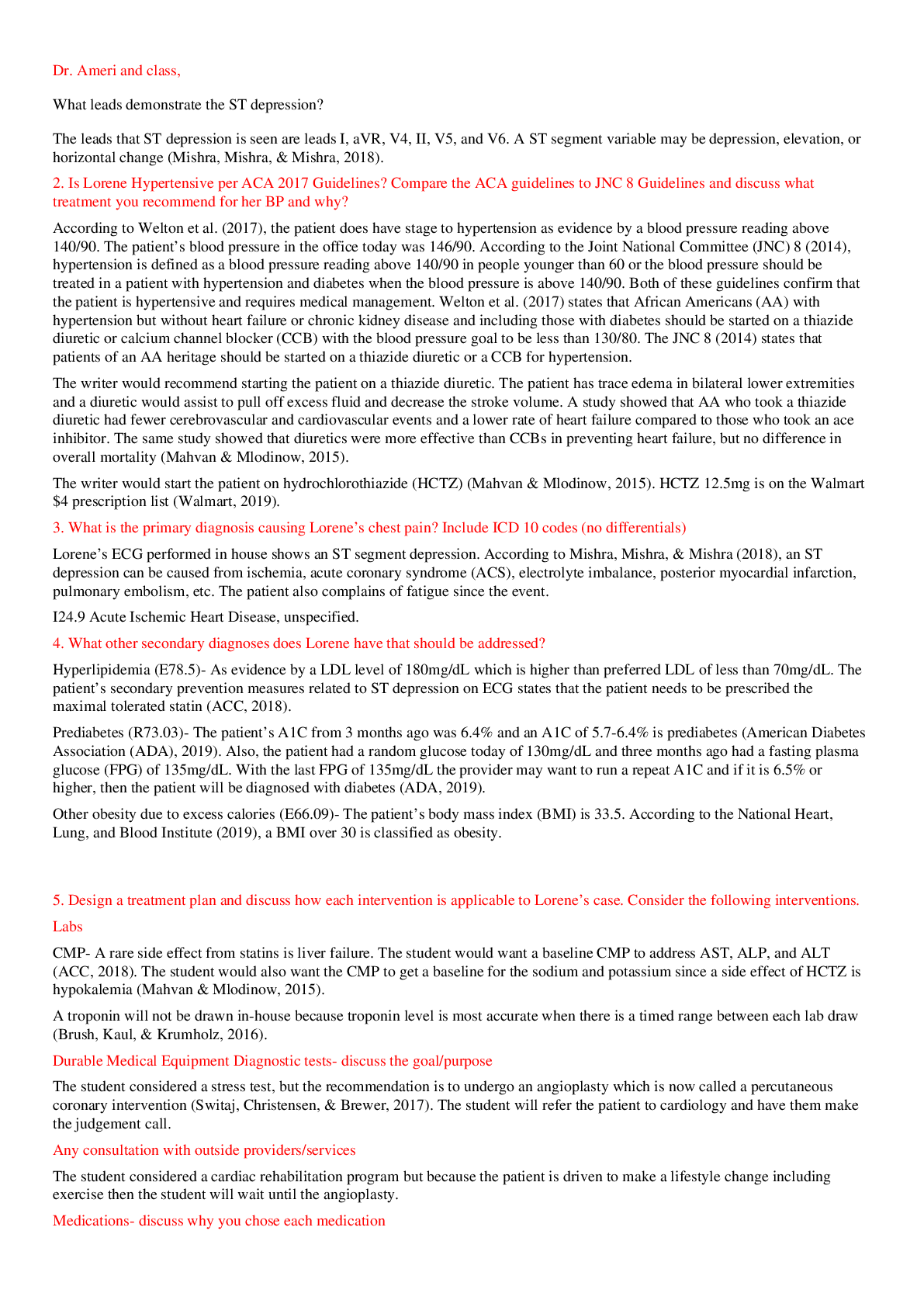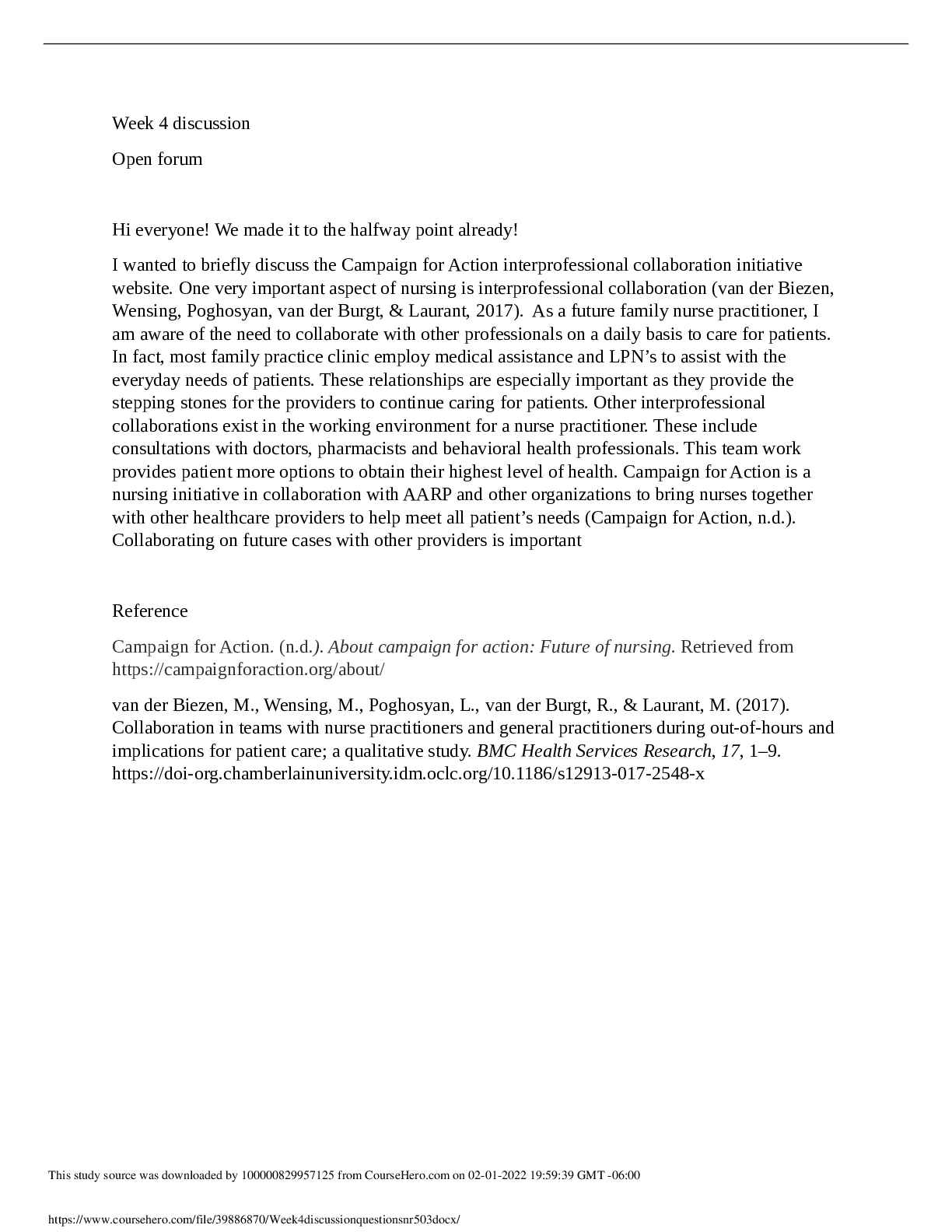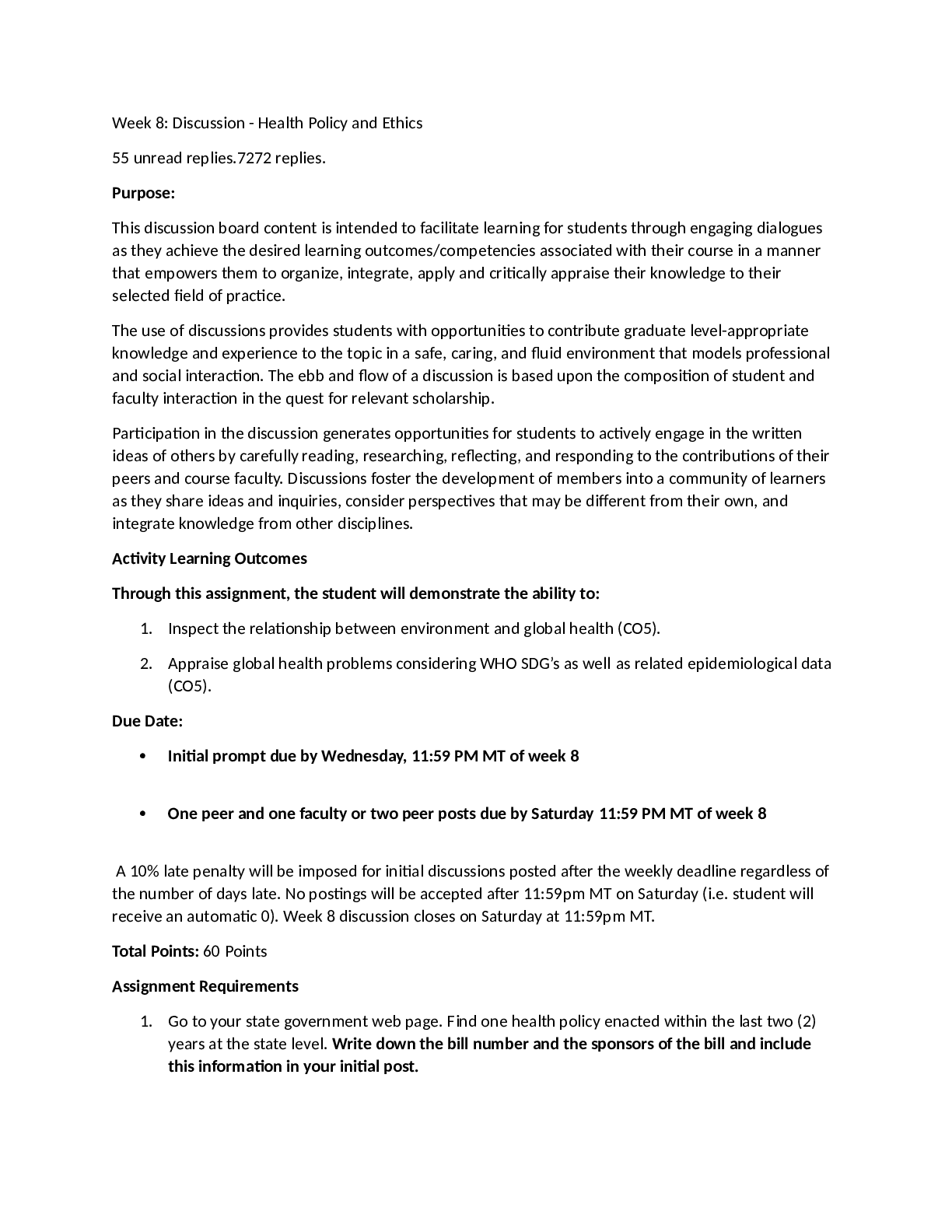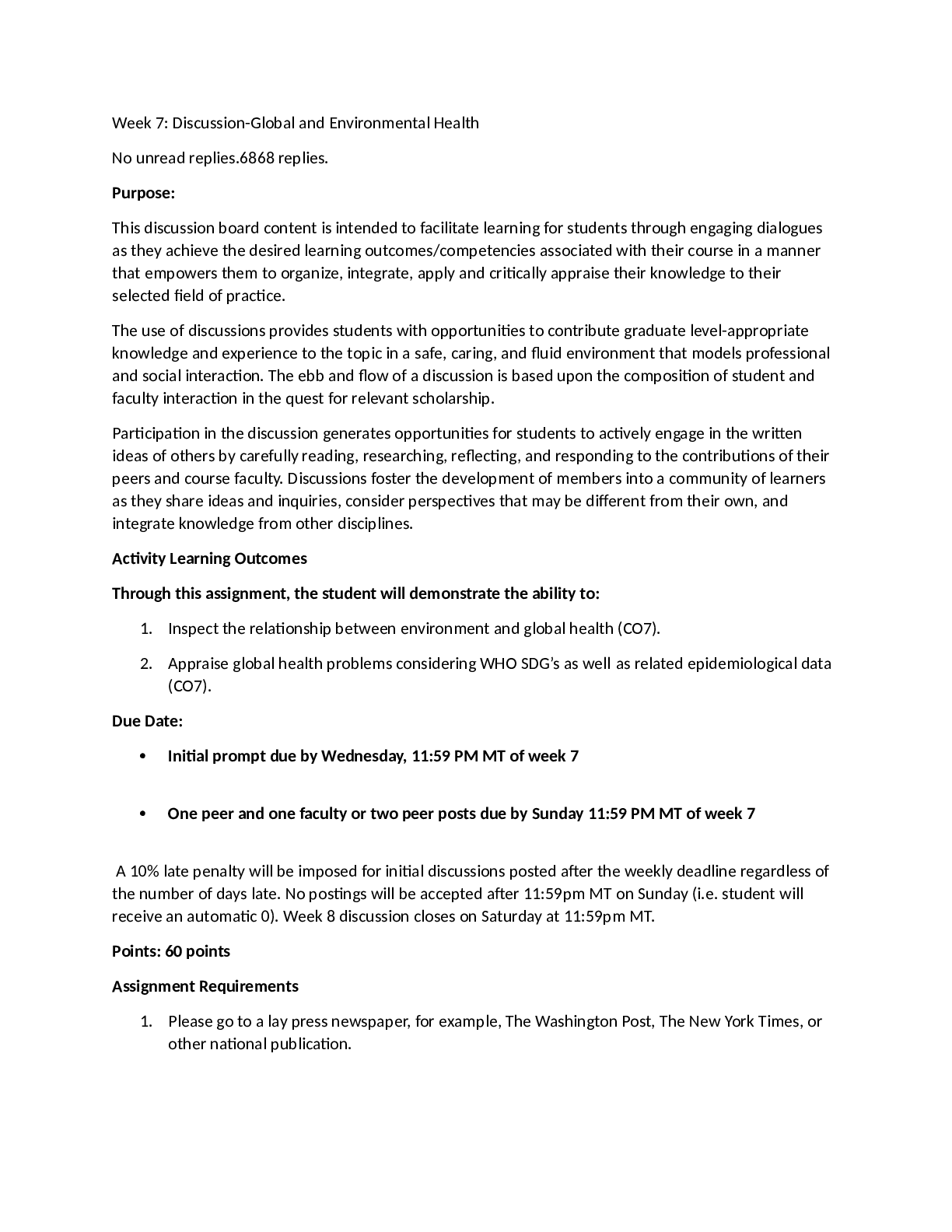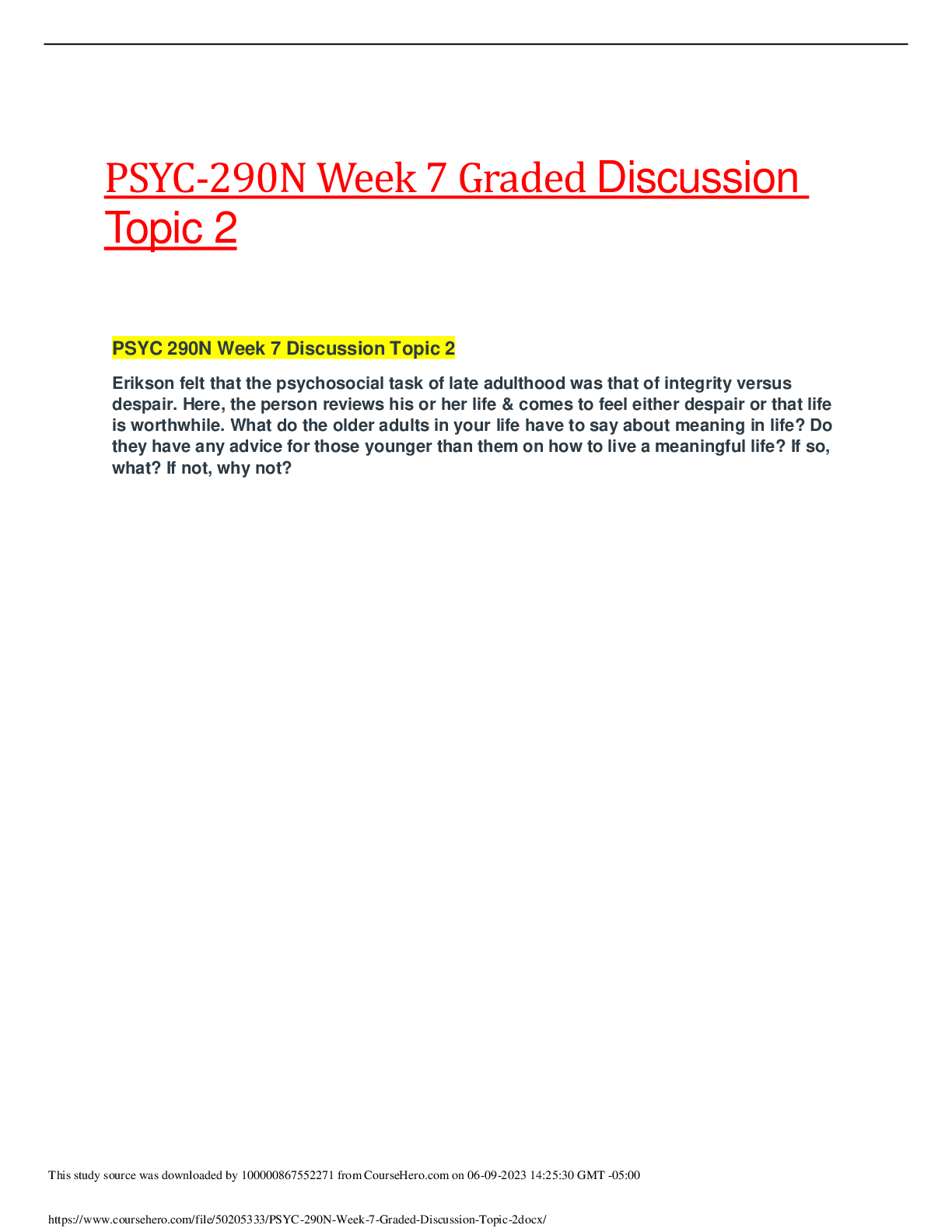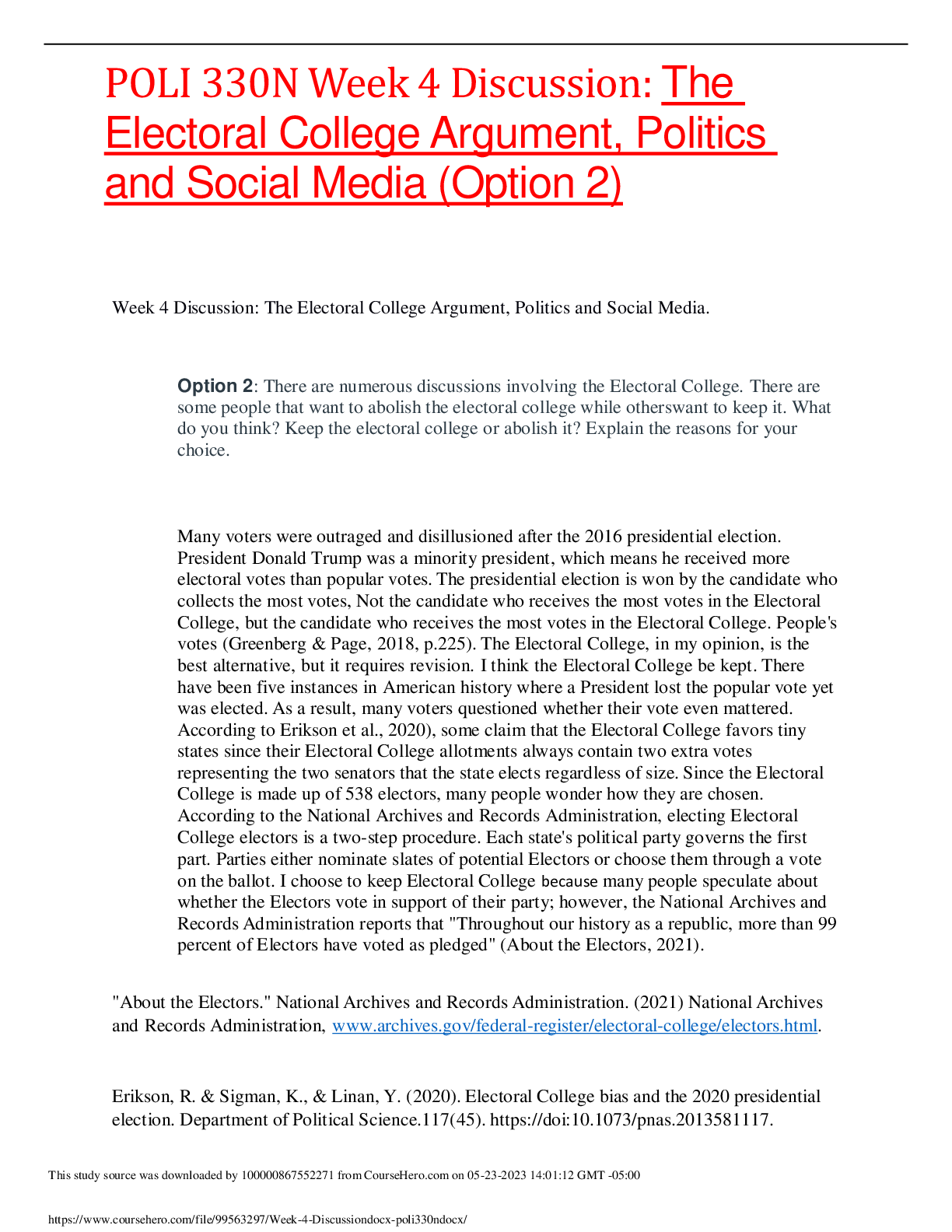*NURSING > DISCUSSION POST > NR 503 Week 3 Discussion, Current Event – Cardiovascular Health (All)
NR 503 Week 3 Discussion, Current Event – Cardiovascular Health
Document Content and Description Below
Topic: Week 3: Discussion- Current Event https://chamberlain.instructure.com/courses/24843/discussion_topics/455920?module_item_id=2839206 1/66 This is a graded discussion: 100 points possible ... due Mar 18 Week 3: Discussion- Current Event 38 74 Search entries or author Reply This week we will explore current events related to epidemiology. You will present a scientific article to the class. Please focus on interpreting the research question, methodology, results, and conclusions from a sample of peer-reviewed scientific literature. Please be sure the article is related to epidemiology, summarizing its contents for the class, and providing a succinct written summary. Current events must have been published within the last six months. Written summaries should include: State the objectives of the study Summarize the study design and findings Provide a reference of the article Provide your opinion on how the "average" reader will respond to the article. Will the article influence decision making or thinking? Does the article leave out any important information? Unread Subscribe (https:// Tina Grinsteiner (hps://chamberlain.instructure.com/courses/24843/users/22975 Mar 11, 2018 Dr. Weaver and Classmates, The current event article I choice related to epidemiology is "Epidemiology Data on the Effectiveness of Influenza Vaccine--Another Piece of the Puzzle. https://academic.oup.com/jid/advance-article/doi/10.1093/infdis/jix635/4816917 This study was based on the effectiveness of the vaccine for influenza and defined vaccine effectiveness as the reduction in the risk of an outcome associated with the vaccination. The study was based on the effectiveness of the inactivated influenza vaccine against medically attended respiratory complications which were associated with the H1N1 over the course of five years from 5/9/2018 Topic: Week 3: Discussion- Current Event https://chamberlain.instructure.com/courses/24843/discussion_topics/455920?module_item_id=2839206 2/66 Reply seven US centers using an observational study based on the test-negative results. The findings resulting from the study showed that the vaccine effectiveness between 2010 to 2014 and 2015 to 2016 were 69%, 56% and 47% respectively. However with the 2015 to 2016, the study analyzed the observed reduction on vaccine effectiveness by also using the difference age categories which found that the estimated vaccine effectiveness was 22% for those born between 1958 and 1979 (Cheng & Subbarao, 2018). It was believed that influenza strains that were encountered early in life had a long-lasting effect on the immune response as well as vaccinations. However, the study showed that 60% of the serological responses to the inactivated influenza vaccines are actually due to the boost of pre-existing antibodies instead of the new vaccine antibodies and the degree of protection will continue to vary from season to season and may be lower in certain population groups and that current vaccines are at the most moderately effective against influenza and need improvement (Cheng & Subbarao, 2018). Unfortunately, the data presented would be difficult for the average individual to understand and comprehend, leaving them to focus only on the conclusion of the study leading the average individual to believe that the influenza vaccine is ineffective in protecting them against the virus and would opt not to receive the vaccine without understanding the risks and complications associated with the influenza virus that they are placing themselves in and those around. Unfortunately, as we have seen over the course of the last couple of years, less and less individuals are receiving the influenza vaccine due to the decrease in the vaccines effectiveness which have lead to an increase in hospitalization and even death related to complications associated with the influenza virus, specifically H1N1 and sub-types of the viruses. What the average individual fails to recognize or understand, is the influenza viruses gradually evolve from year to year making it more difficult to produce an effective influenza vaccine. Tina Cheng, A., & Subbarao, K. (2018). Epidemiological data on the effectiveness of influenza vaccineAnother piece of the puzzle. The Journal of Infectious Diseases, jix635. https://doi.org/10.1093/infdis/jix635 (http Holly Mullen (hps://chamberlain.instructure.com/courses/24843/users/4682 Mar 13, 2018 Tina, Thank you for your post. I also examined an article regarding the influenza vaccine in this week’s TD! This seems like an interesting research study. It is damaging that this virus has so many sub-types that can change and replicate differently every year. 5/9/2018 Topic: Week 3: Discussion- Current Event https://chamberlain.instructure.com/courses/24843/discussion_topics/455920?module_item_id=2839206 3/66 Reply Annually, influenza causes 250,000 – 500,000 deaths. Further, 5- 10% of adults and 20- 30% of children will become symptomatic from this illness. This is 3 to 5 million individuals every year (Puig-Barberà et al., 2016)! The World Health Organization has increased influenza surveillance since the 2009 pandemic influenza season. It is vital to understand the epidemiological and virological data related to illness such as influenza (Puig-Barberà et al., 2016). The study of epidemiology is essential when determining what causes diseases, examining risk factors, and investigating how disease is transmitted. Finding causal factors for disease and eliminating exposure can reduce morbidity and mortality. Likewise, prevention programs, vaccines, and treatments regimes can prevent transmission of illness. It is vital in evidencebased healthcare to examine how illness, such as influenza, can affect healthcare delivery systems, communities, and the history of disease prognosis (Gordis, 2014). Thank you for your post! Holly Mullen References Gordis, L. (2014). Epidemiology (5th ed.). Philadelphia, PA: Elsevier Saunders. Puig-Barberà, J., Burtseva, E., Hongjie, Y., Cowling, B. J., Badur, S., Kyncl, J., Sominina, & GIHSN. (2016). Influenza epidemiology and influenza vaccine effectiveness during the 2014- 2015 season: annual report from the Global Influenza Hospital Surveillance Network. BMC Public Health, 16(1), 1-21. doi:10.1186/s12889-016-3378-1 (http Amy Weaver (Instructor) 5/9/2018 Topic: Week 3: Discussion- Current Event https://chamberlain.instructure.com/courses/24843/discussion_topics/455920?module_item_id=2839206 4/66 Mar 13, 2018 Reply (1 like) Holly, thanks for your additional feedback. So many deaths are caused each year by the flu, yet people often don't seem to give it enough respect to get themselves and their children vaccinated. (http Amy Weaver (Instructor) Mar 13, 2018 Reply (1 like) Tina, thanks for this great information on the influenza vaccine and disease. I have found it interesting that some seasons the vaccine is much more effective than it is in others. I know many people who don't get a flu vaccine due to this high unpredictability of it's effectiveness. Even in years of lower effectiveness, some protection is certainly better than none. Wouldn't you agree? (http Holly Mullen (hps://chamberlain.instructure.com/courses/24843/users/46 Mar 14, 2018 Dr. Weaver, Thank you for your feedback. I agree some protection is definitely better than none! In the United States the CDC recommends annual seasonal influenza vaccination for all individuals greater than 6 months of age. Recognizing the need for ongoing treatment and prevention, the CDC estimates the effectiveness of the influenza vaccination in intervals. Despite unpredictability associated to type of virus, the influenza vaccine remains recommended by the Centers of Disease Control to prevent infections related to current circulating virus. Vaccination continues to prevent thousands of hospitalizations and death (Flannery et al., 2018). The CDC has collected data from nearly 5,000 children and adults with medically attended, laboratory confirmed influenza infection in the United States from November 2, 5/9/2018 Topic: Week 3: Discussion- Current Event https://chamberlain.instructure.com/courses/24843/discussion_topics/455920?module_item_id=2839206 5/66 Reply 2017- February 3, 2018. Data was collected from five study sites with outpatient medical facilities. The predominate virus during this season is influenza A(H3N2). It is estimated that the influenza vaccine effectiveness this year is 36% (Flannery et al., 2018). The CDC recommends vaccination to reduce complications and risk of illness related to the flu. It is important to note that other types of influenza virus are still circulating. While the CDC will continue to monitor the effectiveness of vaccination, providers must recognize treatment with antiviral medications as an adjunct to vaccination is of utmost importance (Flannery et al, 2018)! Thank you, Holly Mullen References Flannery, Chung, Belongia, McLean, Gaglani, Murthy, Zimmerman, Nowalk, M. Jackson, L. Jackson, Monto, Martin, Foust, Sessions, Berman, Barnes, Spencer, & Fry. (2018). Interim Estimates of 2017-18 Seasonal Influenza Vaccine Effectiveness - United States, February 2018. MMWR: Morbidity & Mortality Weekly Report, 67(6), 180-185. doi:10.15585/mmwr.mm6706a2 (http Allyson Hiers (hps://chamberlain.instructure.com/courses/24843/users Mar 16, 2018 Holly, “Influenza virus can be transmitted from persons infected with influenza virus, even those with subclinical infections to individuals who are at higher risk of complications from influenza such as immune-compromised and elder patients. Healthcare facilities are perfect places for th [Show More]
Last updated: 1 year ago
Preview 1 out of 66 pages
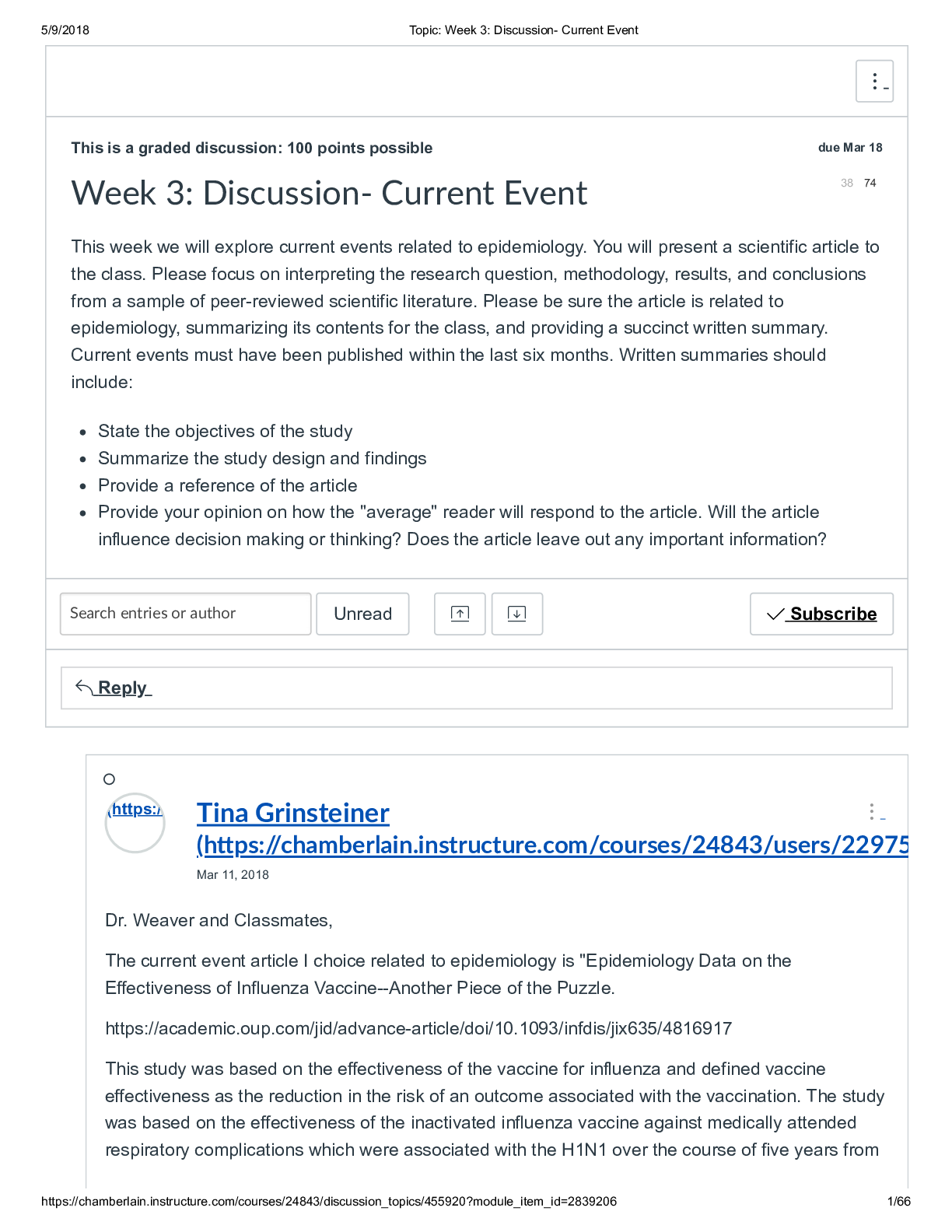
Reviews( 0 )
Document information
Connected school, study & course
About the document
Uploaded On
Apr 30, 2022
Number of pages
66
Written in
Additional information
This document has been written for:
Uploaded
Apr 30, 2022
Downloads
0
Views
69
.png)



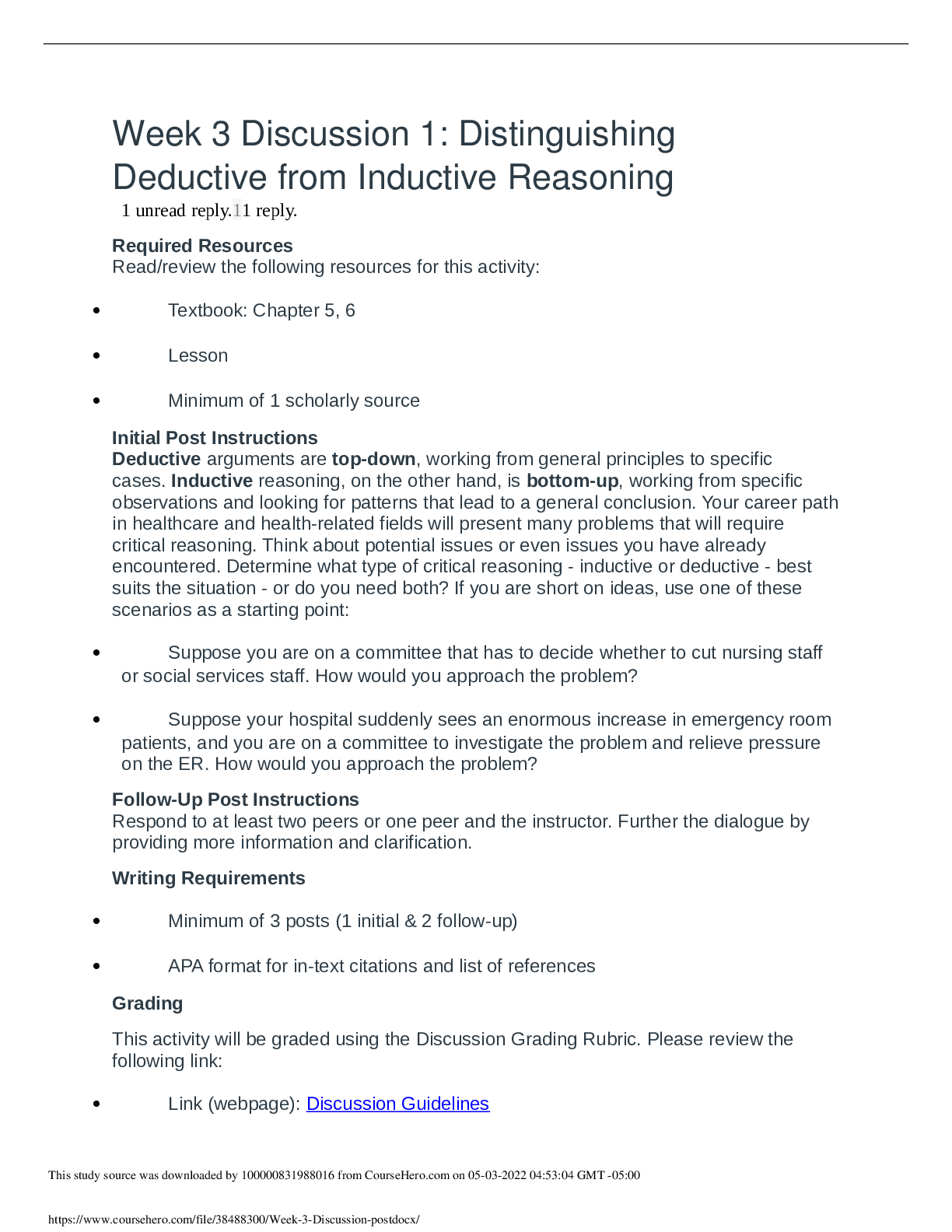

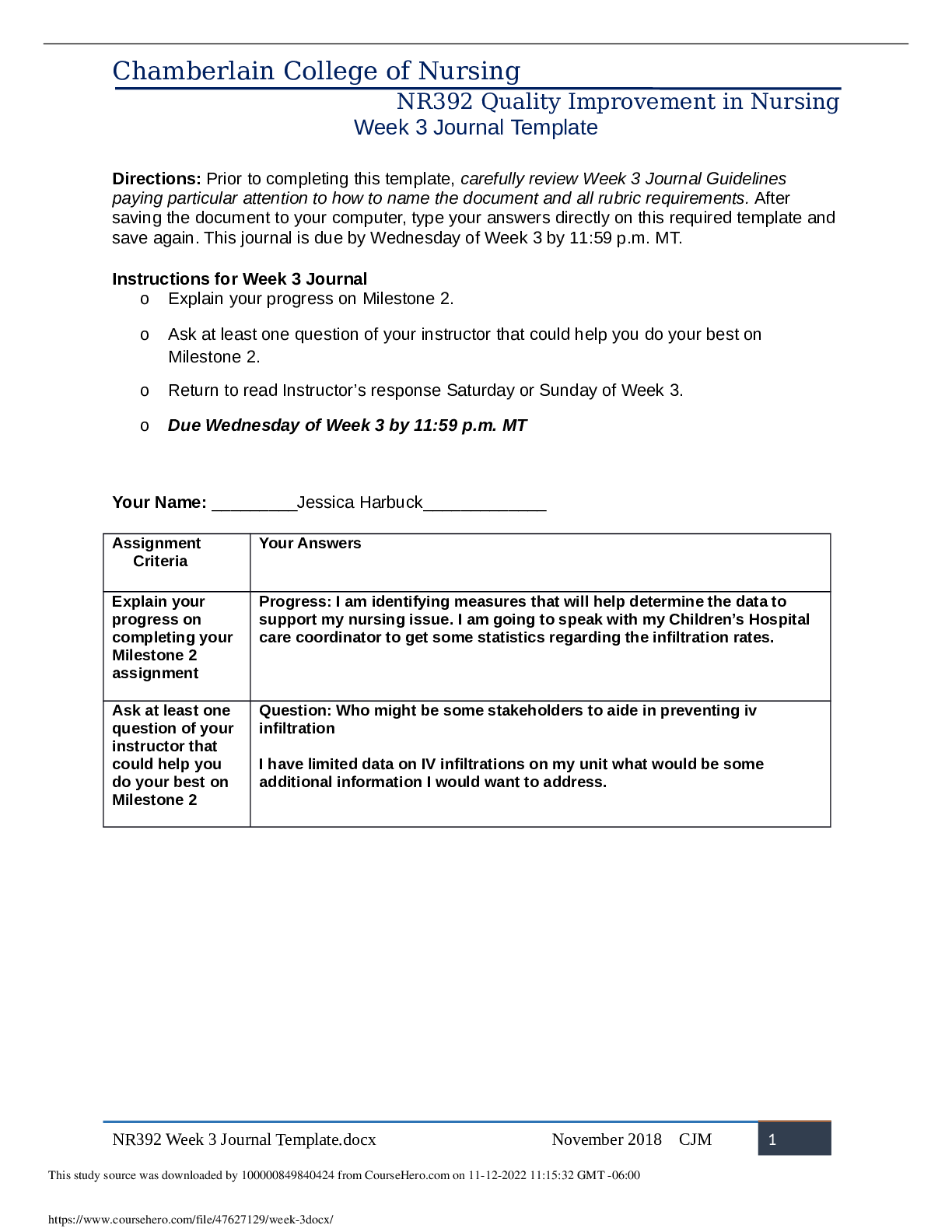

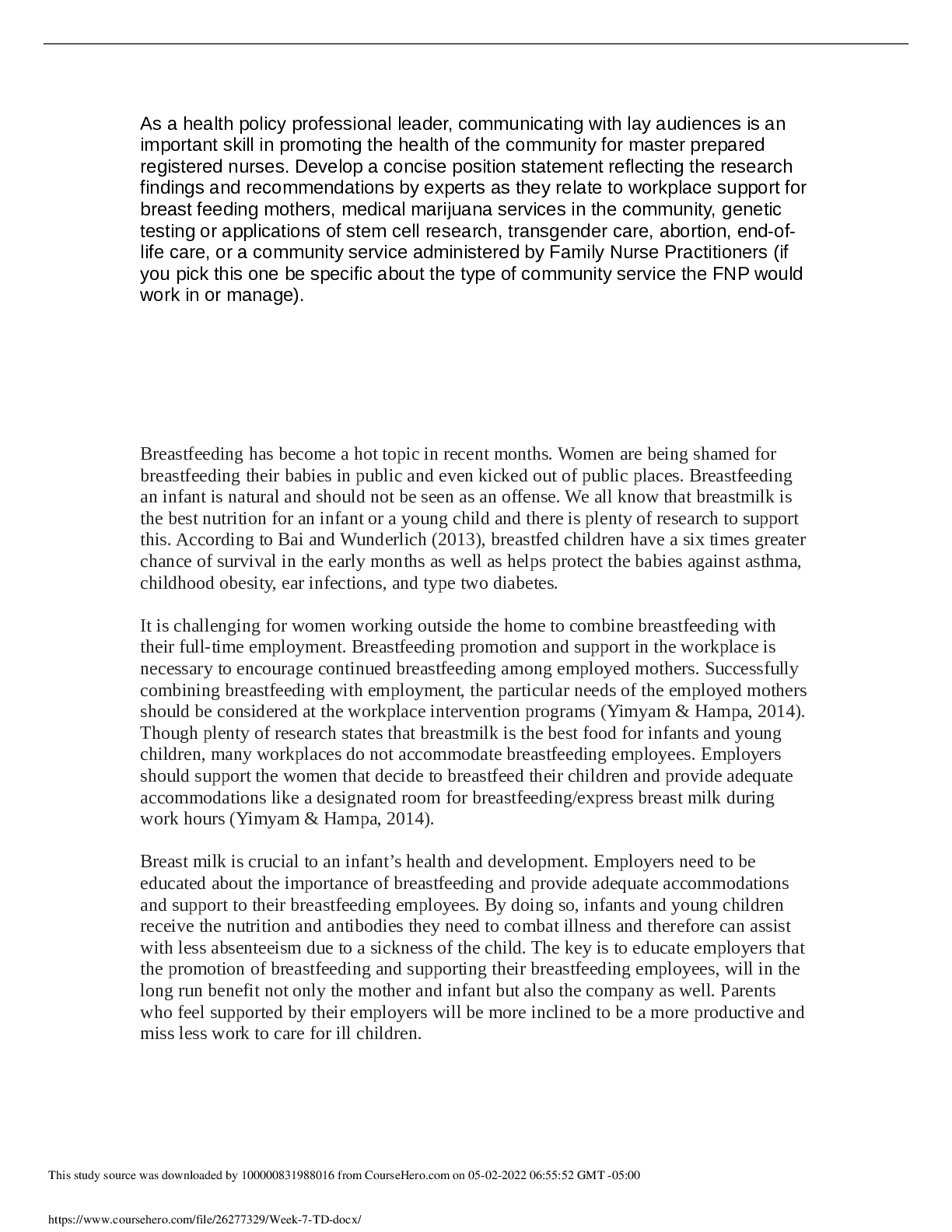

.png)



.png)


